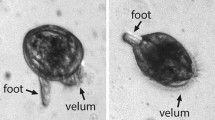Synopsis
Behaviors that precede the daily migrations of mixed-species schools of juvenile grunts (Pomadasyidae), from patch reefs to grass beds at dusk and vice versa at dawn, are defined and utilized to ascertain the precision of the migrations. Although premigratory behaviors differ at dusk and dawn, the migrations are precise twilight events which occur at the same light intensities during dawn and dusk. Histological sections of the retina reveal that both cones and rods are fully exposed to ambient light during the migrations. Under the difficult photic conditions that prevail during migration, the retina is structured photomechanically to maximize the absorption of ambient light. Body colorations of the grunts, which consist mostly of intense colored stripes during the day, are replaced at night by cryptic melanic patterns. The precision of migration, the photomechanical movements in the retina, and the changes in body coloration are considered adaptive because they reduce predation on grunts when they migrate and are most vulnerable to attack. In support of this conclusion, the migrations take place just before the evening and just after the morning ‘quiet period’ - thus they avoid that period during twilight when predation is highest in tropical fish communities.
Similar content being viewed by others
References cited
Ali, M.A. 1959. The ocular structure, retinomotor and photobehavioral responses of juvenile Pacific salmon. Can. J. Zool. 37: 965–996.
Ali, M.A. 1971. Les réponses réstro-motrices: caractères et méchanismes. Vision Res. 11: 1225–1288.
Fishelson, L., D. Popper & N. Gunderman. 1971. Diurnal cyclic behavior of Pempheris ovalensis (Pempheridae, Teleostei). J. Nat. Hist. 5: 503–506.
Gladfelter, W. B. 1978. Twilight migrations and foraging activities of the copper sweeper, Pempheris schomburgki (Teleostei, Pempheridae). Mol. Biol. (In Press).
Hobson, E.S. 1965. Diurnal-nocturnal activity of some inshore fishes in the Gulf of California. Copeia 3: 291–302.
Hobson, E.S. 1968. Predatory behavior of some shore fishes in the Gulf of California. U.S. Fish Wildl. Serv., Res. Rep. 73: 1–92.
Hobson, E.S. 1972. Activity of Hawaiian reef fishes during the evening and morning transitions between daylight and darkness. U.S. Fish. Bull. 70: 715–740.
Hobson, E.S. 1973. Diel feeding migrations in tropical reef fishes. Helgoländer wiss. Meeresunters. 24: 361–370.
Hobson, E.S. & J.R. Chess. 1973. Feeding oriented movements of the atherinid fish Pranesus pingus at Majuro Atoll, Marshall Islands. U.S. Fish. Bull. 71: 777–786.
Hobson, E.S. & J.R. Chess. 1976. Trophic interactions among fishes and zooplankters near shore at Santa Catalina Island, California. U.S. Fish. Bull. 74: 567–598.
Le Grand, Y. 1968. Light, Colour and Vision. Second Edition, English translation. Chapman and Hall, London. 564 pp.
Major, P.F. 1977. Predator-prey interactions in schooling fishes during periods of twilight: a study of the silverside Pranesus insularum in Hawaii. U.S. Fish. Bull. 75: 415–426.
McFarland, W. N. & F. W. Munz. 1976. The visible spectrum during twilight and its implications to vision. pp.249–270. In: G. C. Evans, R. Bainbridge & O. Rackham (ed.). Light as an Ecological Factor, Vol. II. Blackwell Sci. Publ., London.
Morin, J.G. A.H. Harrington, K. Nealson, N. Krieger, T.O. Baldwin & J.W. Hasting. 1975. Light for all reasons: versatility in the behavioral repertoire of the flashlight fish. Science 190: 74–76.
Munz, F.W. & W.N. McFarland. 1973. The significance of spectral position in the rhodopsins of tropical marine fishes. Vision Res. 13: 1829–1874.
Ogden, J.C., R.A. Brown & N. Salesky. 1973. Grazing by the echinoid Diadema antillarum Philippi: formation of halos around West Indian patch reefs. Science 182: 715–717.
Ogden, J.C. & N.S. Buckman. 1973. Movements, foraging groups and diurnal migrations of the striped parrotfish Scarus croicensis Block (Scaridae). Ecology 54: 589–596.
Ogden, J.C. & P.R. Ehrlich. 1977. The behavior of heterotypic resting schools of juvenile grunts (Pomadasyidae). Mar. Biol. 42: 273–280.
Ogden, J. C. & J. C. Zieman. 1977. Ecological aspects of coral reef-seagrass bed contacts in the Caribbean. pp. 378–382. In: Proc. 3rd Int. Symp. Coral Reefs (1, Biology).
Starck, W.A. II & W.P. Davis. 1966. Night habits of fishes of Alligator Reef, Florida. Ichthyol. Aquarium J. 38: 313–356.
Walls, G. L. 1942. The Vertebrate Eye and Its Adaptive Radiation. Reprinted 1963, Hafner Publ., New York. 785 pp.
Author information
Authors and Affiliations
Rights and permissions
About this article
Cite this article
McFarland, W.N., Ogden, J.C. & Lythgoe, J.N. The influence of light on the twilight migrations of grunts. Environ Biol Fish 4, 9–22 (1979). https://doi.org/10.1007/BF00005923
Received:
Accepted:
Issue Date:
DOI: https://doi.org/10.1007/BF00005923




